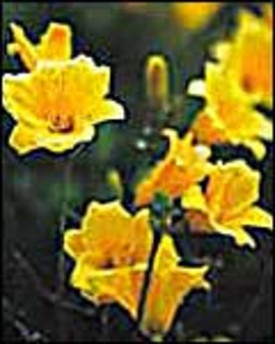Besides the traditional golds and oranges, you can find daylily flowers in shades of red, pink, and purple, including some very pale pastels that approach pure white. Some of the most interesting new varieties, called eyed daylilies, are patterned with a zone of different color around the throat.
Daylilies are remarkably adaptable and will thrive in full sun to part shade in just about any soil type. Dwarf varieties pair well with hardy geraniums, bellflowers, and penstemon, and look great in front of clematis and climbing roses. Large varieties complement coneflowers, Shasta daisies, coreopsis, monarda, and tall phlox.
With the great selection available, choosing a variety can be a challenge. If you’re adding daylilies to an existing perennial garden, think about what role you’d like them to play. Is your garden in need of some livening up? Consider Stella de Oro, for a season-long splash of bright yellow. Does one of your gardens need some early summer color? Grape Magic’s show of deep scarlet flowers lasts for weeks in early to mid summer. Or you may simply want to add a conversation-starter like Barbara Mitchell, whose huge, orchid pink flowers have deep yellow veining in the throat.
Here are some suggestions for attractive flower combinations:
| Primary colors enliven a garden. This trio of bright-flowered, medium-sized plants performs best in part shade in warm climates, and in full sun to part shade in cooler regions.
|
||||
 |
 |
 |
||
| ‘Paprika’ Achillea ‘Paprika’ has brilliant flat clusters of red flowers with cheery yellow centers atop sturdy 18-in. stems. Finely divided, fern-like foliage is grayish green.
|
‘Stella de Oro’ Daylily This award-winning dwarf daylily flowers prolifically and repeat blooms for a super-long bloom period. Grows 18 to 24 inches tall.
|
‘Johnson’s Blue’
Geranium This popular geranium produces a heavy shower of lavender-blue flowers over many weeks in late spring. Grows 15-18 inches tall.
|
||
| The muted colors and light, airy textures of these relatively
large plants make them attractive—but not overwhelming—companions for daylilies.
|
||||
 |
 |
 |
||
| ‘Sunny Border Blue’ ‘Sunny Border Blue’ produces abundant spikes of violet-blue flowers above crisp green foliage beginning in midsummer through fall. Grows to 2 feet tall.
|
‘Goat’s Beard
(Aruncus) Goat’s beard is a one of the few tall shade plants available. This large perennial has creamy blooms, that reach up to 6 feet tall.
|
Penstemon
‘Husker Red’ Handsome burgundy-red spring foliage and stems contrast nicely with ‘Husker Red’s’ summer display of white, flowers. Grows 2-4 feet tall.
|
||
| Extend the bloom season by planting daylilies with tall summer bloomers such as garden phlox. The phlox will bloom later than most daylily varieties, extending the flower show into early fall.
|
||||
 |
 |
 |
||
| Phlox paniculata ‘Delta Snow’ Bears fragrant, tubular flowers atop stiff, upright stems, which seldom need staking. ‘Delta Snow’ typically grows 3-4 feet tall. with narrow, lance-shaped foliage.
|
‘Phlox paniculata
‘David’ ‘David’ is the most mildew-resistant garden phlox available. Its domed clusters of fragrant, pure-white flowers appear on 2-3 foot tall plants.
|
Phlox paniculata
‘Blue Boy’ Produces large trusses of soft, fragrant, lavender-blue flowers, each with a white center. The 3 foot tall plants have lance-shaped leaves.
|
||
| Growing perennials such as lavendar and baby’s breath as companions to daylilies provide not only contrasting flower colors, but diverse foliage textures as well.
|
||||
 |
 |
 |
||
| Lavendula
‘Fred Boutin’ ‘Fred Boutin’ boasts fragrant, flower spikes that are exceptionally long, and the foliage is velvety white. Sheer back after first flush of blooms for more flowers.
|
Gypsophila ‘Viette’s
Dwarf’ ‘Vivette’s Dwarf’ baby’s breath is compact and does not require staking. Its early summer sprays of double, blush-pink flowers turn white as they mature.
|
Liatris spicata
‘Kobold’ ‘Kobold’ gayfeather is compact and can be planted in front of a flower garden. Its spikey purple flowers bloom for weeks in summer.
|
||
Credit: National Gardening Association




























